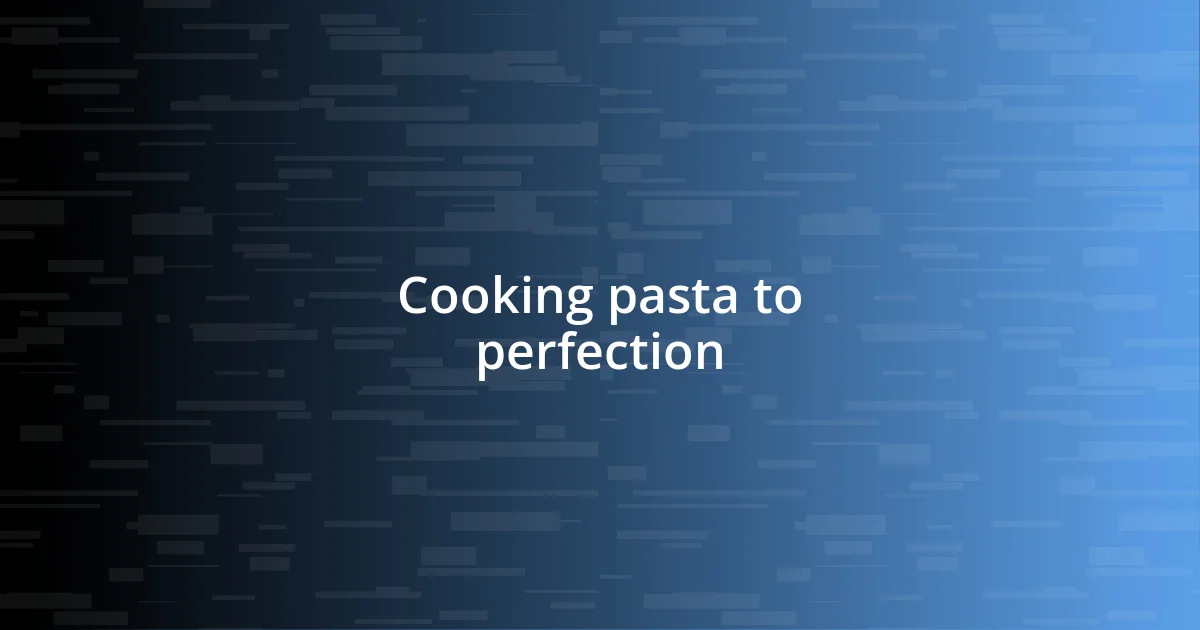Key takeaways:
- Making homemade pasta connects you to the ingredients and the culinary process, creating meaningful kitchen experiences.
- Choosing high-quality ingredients, especially the right flour and fresh eggs, significantly enhances the texture and flavor of pasta.
- Proper techniques in rolling, cutting, cooking, and pairing with sauces are crucial for achieving the best results in homemade pasta dishes.

Introduction to homemade pasta
There’s something truly magical about making pasta from scratch. When I first embarked on this culinary adventure, I didn’t just want to cook; I yearned to connect with the ingredients and the process. Who could resist the allure of kneading dough, feeling it transform under your hands?
I still remember the first time I rolled out my own pasta. It was messy, flour flying everywhere, and my kitchen looked like a flour bomb had exploded. But as I twirled the fresh fettuccine in my fingers, a sense of accomplishment washed over me. Isn’t it fascinating how something so simple can spark such joy and creativity?
Making homemade pasta isn’t just about the end product; it’s an experience filled with warmth and tradition. Each batch tells a story—perhaps one of family gatherings around the dinner table or evenings spent laughing with friends. It invites us to cherish the moments spent in the kitchen. How often do we slow down to appreciate the artistry of cooking? I’ve learned that homemade pasta can be not just a meal but a heartfelt journey.

Choosing the right ingredients
Choosing the right ingredients is a pivotal step in perfecting homemade pasta. I’ve tried various types of flour over the years, and I can tell you that not all flours are created equal. For instance, 00 flour, which is finely milled Italian flour, yields a wonderfully silky texture that pairs beautifully with sauces, while all-purpose flour might give you a denser bite. It became quite clear to me that the choice of flour can drastically influence the texture of your pasta.
While flour is the star of the show, don’t overlook the importance of eggs. When I first experimented with using farm-fresh eggs, the richness of the yolks made a noticeable difference. Each pasta dish lifted off the plate with a delightful flavor that transported me right back to Italy. It’s incredible how a simple ingredient can elevate the entire experience.
Lastly, consider using high-quality ingredients for added depth. I remember my first time trying organic semolina flour and how it transformed my pasta into something truly heavenly. Ingredients are not just components; they bring stories and flavors from their origins. Each time I source fresh, local ingredients, I feel connected to the community that produced them, and that connection truly enhances the dish.
| Ingredient | Description |
|---|---|
| 00 Flour | Finely milled Italian flour for silky pasta. |
| All-Purpose Flour | Versatile flour; may produce a denser texture. |
| Fresh Eggs | Rich yolks enhance flavor and texture. |
| Organic Semolina | Adds depth and character to the pasta. |

Mastering the pasta dough
Once I began to experiment with pasta dough, I realized that mastering it is all about feel. The dough should be soft but not sticky, and it takes practice to get it right. I vividly recall the moment I found that perfect balance—my dough was smooth and pliable, and I could knead it with ease. That tactile connection made the effort worthwhile, and I could hardly wait to see the results of my labor.
- Start with a well-measured flour-to-egg ratio, usually around 100 grams of flour for each large egg, adjusting based on humidity and flour type.
- Knead the dough until it’s elastic, which usually takes about 10 minutes; this step truly enhances the texture.
- Let the dough rest for at least 30 minutes wrapped in plastic wrap; this relaxation is crucial for easier rolling.
- Don’t hesitate to experiment with hydration; adding a touch of water or oil can make the dough more forgiving.
- Remember to incorporate plenty of flour on your surface to prevent sticking during rolling—it makes a world of difference!
After several trials, I discovered that even the ambient temperature could affect my results. On particularly humid days, I found that a bit of extra flour could save the dough. This journey has been more than just mastering a recipe; it’s been an exploration of my own capabilities. Every small adjustment taught me to trust my instincts in the kitchen, empowering me with a newfound confidence that I can share with every eager home cook.

Techniques for rolling and cutting
When it comes to rolling and cutting pasta, I always emphasize the importance of patience and technique. I remember my first time with a rolling pin; I was too eager and ended up with uneven thickness. Now, I take my time to roll the dough out to about 1-2 mm thick, ensuring a consistent texture that cooks evenly. I often think, how can something so simple require such attention? But trust me, it’s this careful process that elevates the final dish.
Using a pasta machine was a game-changer for me. The first time I cranked it through, the dough transformed right before my eyes, becoming silky and flat with minimal effort. I like to start at the widest setting and gradually work my way down—this gives me control over the thickness and ensures I don’t rush the process. It’s fascinating how just a few passes can create that perfect sheet of pasta. Have you ever experienced that feeling of accomplishment when the dough comes out just right?
Cutting the pasta is just as crucial as rolling it. I often take the time to dust my work surface with flour to prevent sticking. For shapes like fettuccine or tagliatelle, I fold the rolled sheets lightly and slice with a sharp knife, getting a sense of satisfaction each time I see the neat strands fall away. A tidy workspace is essential; it keeps the experience enjoyable, plus it’s much easier to clean up later. Trust me, it’s worth that extra effort when it comes to serving a beautifully presented dish!

Cooking pasta to perfection
Cooking pasta to perfection starts with the right boiling technique. I’ve experimented with various methods, but one thing remains constant: a generous amount of salted water is essential. I remember the first time I added salt – the pasta transformed into a flavor-packed delight. It also helps to bring the water to a rolling boil before adding the pasta, which keeps it from becoming gummy. This simple action truly sets the foundation for a mouthwatering dish.
Timing is another key element. I often tell myself to be present while my pasta cooks. Think about it: stepping away for even a moment can lead to overcooked pasta. I’ve been there, staring at the clock, trying to calculate the right moment to drain the pasta. It’s a delicate balance! I usually taste a strand a minute or two before the package suggests it’s done. That little taste test is what gives me that satisfying al dente texture, which I find so crucial in any pasta dish.
Lastly, remember not to rinse your pasta after cooking. I made that mistake early on; hoping to remove excess starch, I inadvertently stripped away flavor. Instead, I now keep a cup of pasta water handy, which helps adjust the sauce’s consistency and keeps everything cohesive. The joy of watching my sauce cling perfectly to each strand of pasta continues to be one of my happiest kitchen moments. What about you—don’t you just love that fulfilling feeling when everything comes together beautifully?

Sauces that complement pasta
When it comes to pairing sauces with homemade pasta, I find that freshness and balance are key. One of my go-to sauces is a simple tomato basil. I’ll never forget the first time I used fresh tomatoes from the farmer’s market instead of canned ones; the flavor was a game-changer. The vibrant red sauce, tinged with bright green basil, not only looks stunning but creates a symphony of flavors that really highlights the pasta’s texture. Don’t you feel that fresh ingredients can transform a meal in an instant?
Another standout choice in my kitchen is a rich, creamy Alfredo. The luxuriousness of heavy cream combined with butter and Parmesan cheese creates a hug in a bowl, perfect for a cozy night in. I vividly remember the first time I whisked the cheese in until it melted just right, forming that dreamy sauce. My heart raced as I poured it over my fettuccine—it felt like magic! Have you ever had a dish that just warms you from the inside out?
For those days when I crave something lighter, I often whip up a garlic and olive oil sauce, also known as Aglio e Olio. Just a few sautéed garlic cloves in good olive oil, tossed with red pepper flakes, creates a beautiful simplicity that sings when paired with my homemade spaghetti. I recall the thrill of experimenting with the amount of heat to get that perfect kick, and the end result is always a delight. What’s really special is how a dish this simple can feel indulgent while reminding me of the beauty in minimalism.

Storing and reheating pasta
Storing pasta properly is essential to maintain its quality. I usually let my homemade pasta cool completely before placing it in an airtight container, ensuring it doesn’t lose its shape or flavor. There’s nothing worse than pulling out a clump of gooey pasta, right? For longer storage, I recommend freezing it. I often lay the fresh strands in a single layer on a baking sheet first, flash-freezing them before transferring to a freezer bag. This way, they don’t stick together, and I can take out just what I need later.
When it comes to reheating pasta, there are a couple of methods I find work best. If I’m in a hurry, I like to toss my leftover pasta in a pan with a splash of water and cover it. The steam works wonders! I remember the first time I tried this; I was amazed at how it transformed dry pasta into something that felt fresh and new again. On lazy days, though, I opt for the microwave. I’ll pop it in for just a minute or so, stirring halfway through, which ensures even heating without drying it out. Isn’t it comforting to have quick solutions ready for those busy weeknights?
And if you’re wondering about the flavors—I always add a little drizzle of olive oil or a spoonful of my pasta sauce while reheating. This little touch makes all the difference and can really bring back that homemade feel. It’s similar to reviving an old favorite song; suddenly, everything feels warm and familiar. What’s your favorite way to enjoy your pasta leftovers?














